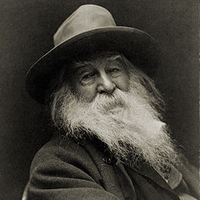The World Below the Brine by Walt Whitman: Summary and Analysis
The speaker of the poem is sitting near the sea and looking at the wonderful variety of plant and animal life inside it. First he describes the plants under the water, and then the colors. Next he describes the creatures and finally the 'society' inside the water. The poem develops typically from a description into a meditation, but the poet remains almost silent about his feelings towards the world below the sea.

Walt Whitman (1819-1892)
He says towards the end of the poem that the world of other creatures in the world of water (hydrosphere) is also a world of its own. Finally, he is encouraged to imagine how very different other worlds must be in this universe. If the two worlds in this very earth-on land and in water-are so different, the world in other places of the universe must be more different and more fascinating. The poem is a tribute to the beauty and variety of the nature. The imagery and the imagination make the poem typically Romantic. The poem is based on the poet's beloved ocean near his home in Long Island, New York, in the United States.
This poem is a romantic poem in a sense that the speaker meditates about the variety of life in the sea and the uniqueness of it. Then he wonders if there are other worlds than the human world outside of what we know. The present poem is a piece of meditation set on the sea shore. The persona first describes the amazing variety of plants and animals, shapes, colors, sizes, and types of them. He calls the sphere below the sea (brine) a "world" because it has its own tribes, wars, pursuits-its own society and laws. Then, after wondering at the difference of the human world from the marine (sea) world, he finally wonders to imagine whether there are other worlds too, and, if so, how different they might be!
This is a typical American romantic poem for the sense of wonder about the nature. Indirectly, it criticizes the common assumption and the attitude that the world of human beings is the only world and a supreme one. Human beings believe they are superior to all other animals. But that is their own viewpoint. Other creatures live their lives in their own ways, and they must have their own values, viewpoints and experience. The poet describes the marine world in detail and compares it with the terrestrial (land) world, but he seems to appreciate the variety of the marine world more. The selection of details is very meaningful. Lines 2 and 3 give a variety of plants: sea-lettuce, lichens, strange flowers, pink turf, etc. Line 4 is about the variety of colors. Line 5 to 8 describe a variety of animals ranging from the biggest to the smallest, fastest and the slowest, the strong, the weak, the violent, the helpless, and all sorts of them. The poet wonders at all those.
The poem is a descriptive poem that develops into mediation. From line 1 to 8, we see the poet describing the world below the brine. But form 9, he begins to meditate. His meditation upon the 'brine' world is like a real soliloquy: it is indirect, implicit and erratic, as if he is speaking alone and passionately. There is some dramatic element, too, in this meditation; it is highly imaginative and rather emotional too. The variety and the difference tell him that it is altogether a different world. There are tribes as he can see. There are wars. There are pursuits (aims) and struggles for existence. They have a different mode of breathing and living. There must be their own kind of organizations, laws, societies; much more is known to us from researches after Whitman. The world below the brine is fascinating and it captures our imagination and we meditate with the poet. We also imagine whether there are other worlds.
The poem is written in long prose-like lines. Whitman was really indifferent to form and music. The poem is unformed and random as regards its meter and such other devices. But the free flowing lines resemble the free associative process of meditation more than controlled metrical line. So the style is appropriate. The poem is simple in diction and overall meaning.
Site this Page!
Shrestha, Roma. "The World Below the Brine by Walt Whitman: Summary and Analysis." BachelorandMaster, 19 Nov. 2013, bachelorandmaster.com/britishandamericanpoetry/the-world-below-the-brine.html.
Related Topics
When Lilacs Last in the Dooryard Bloom'd: Analysis
Crossing Brooklyn Ferry: Summary
Crossing Brooklyn Ferry: Analysis
Song of Myself (Section 1: Summary & Analysis)
Song of Myself (Section 6: Summary & Analysis)
Song of Myself (Section 11: Summary & Analysis)
Song of Myself (Section 52: Summary & Analysis)
 |
bachelorandmaster.com |